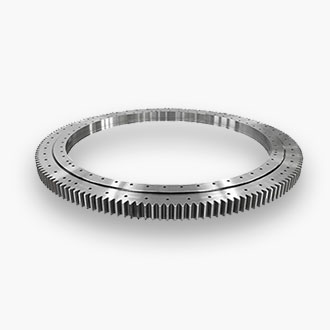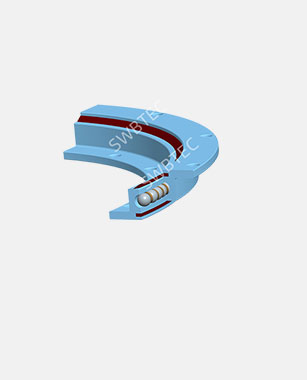
SWBTEC recommend customers to choose double-row slewing bearing according to the customer's requirements for bearing load capacity.
The double row ball slewing bearing can withstand larger axial loads, appropriate radial loads and overturning moments. Compared with three-row slewing bearings, the double row slewing bearing can lower procurement costs for customers.
The three row roller slewing bearing meets the requirements of small size and large load. However, when the eccentricity of the axial load is relatively small, the bearing capacity of the three-row slewing bearing is rich and the cost is relatively high.
Our company engineers have strong product design capabilities, please feel free to contact us if you need double row slewing bearing.

Double row slewing bearing is a kind of slewing bearing which is used on ship cranes. There are generally 4 pieces of slewing bearings on ships to share the loading and unloading operations of the ship, and the service life is generally required to be 6-10 years. Therefore, it is very important to ensure the reliability and durability of the slewing bearings.
The characteristics of marine slewing bearings are high flexibility, and relatively high rotational speed and the load is generally between 15-30 tons, so four-point contact ball bearings are widely used. But what are the design features and advantages of single-row and double-row ball bearings?
First of all, the height of the single row ball slewing bearing should be high, and the steel ball should be 60-70mm to ensure that the bearing capacity is competent and the sealing performance is better. In the early use of the bearing, the application is very high, and the user feedback is good. The characteristic is that the height is high and the steel ball is enlarged, which improves the rigidity and strength of the bearing and is a very good choice.
The double row ball bearing is based on the consideration of flexibility of the slewing bearing, and the structural consideration which increased to reduce the excessive fatigue of the raceway and the steel ball, thereby improving the life and stability of the slewing bearing. The design considerations are perfect, but the application process is flawed, and the raceway force sometimes appears eccentric.
Combining the slewing bearings of the two structures, because the starting points are slightly different, they both have a good and stable record on the ship crane. From the feedback, the advantages and disadvantages are not obvious, and both structures are still good choices. Of course, the price of double-row slewing bearings is significantly higher than that single-row slewing bearings.
Ensure Cleanliness:
Before installation, make sure the mounting surfaces and mating components are clean and free from debris, dirt, or other contaminants that could affect the bearing's performance.
Proper Alignment:
Ensure accurate alignment of the double row slewing bearing with the mating components. Misalignment can lead to increased stress, premature wear, and reduced bearing life.
Torque Specifications:
Follow the manufacturer's recommended torque specifications for tightening the mounting bolts. Over-tightening can cause excessive preload, while under-tightening can lead to looseness and misalignment.
Lubrication:
Apply the appropriate lubricant to the surfaces of double row ball bearing during installation. Follow the manufacturer's recommendations for the type and quantity of lubricant to be used. Adequate lubrication helps reduce friction, minimize wear, and dissipate heat effectively.

 English
English  日本語
日本語  français
français  Deutsch
Deutsch  Español
Español  italiano
italiano  русский
русский  português
português  العربية
العربية  Türkçe
Türkçe  Polska
Polska  Nederland
Nederland 



























